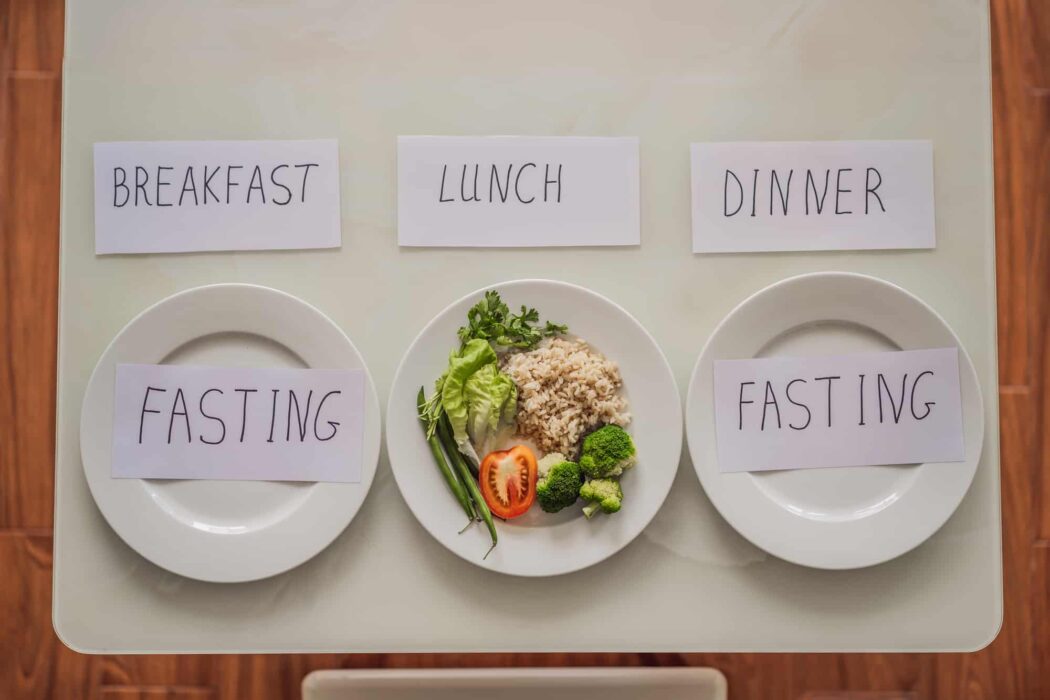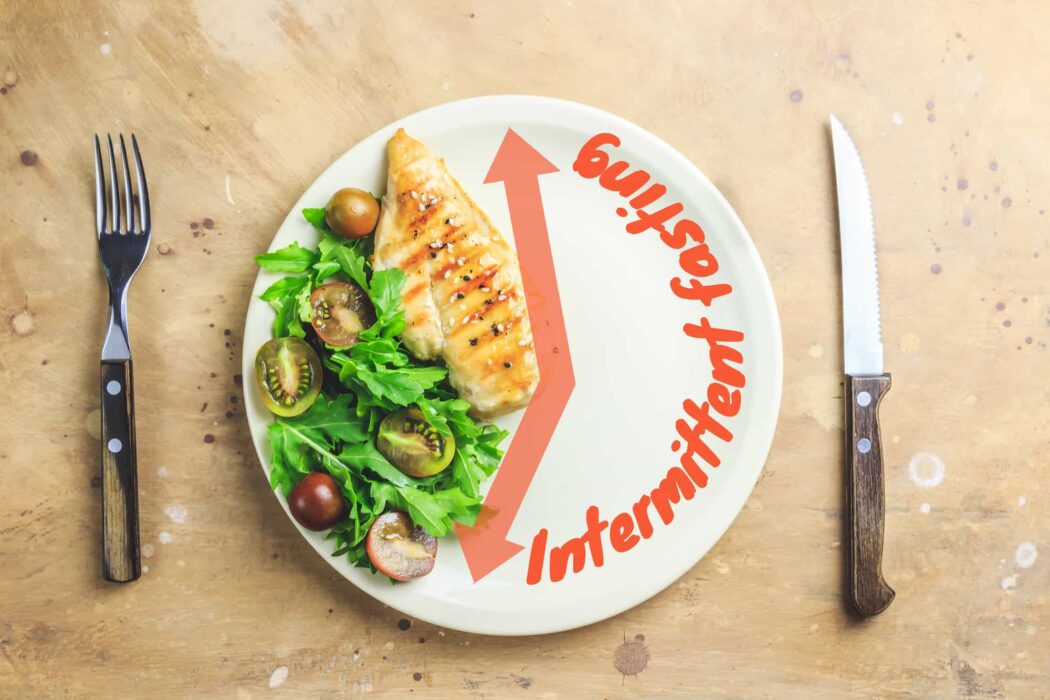Experts have been arguing about intermittent fasting for years. Some believe that it is useful. Others see additional stress on the body in this healthy trend. However, many of us struggle to balance the ability to enjoy our favorite foods and stay fit. Many techniques are outdated and demotivating, making you want to try something new.
Recently, intermittent fasting has become one of the most common types of fasting. Modern nutritionists and endocrinologists claim that temporary abstinence from food really brings the desired effect.

Sometimes we resort to intermittent fasting without even knowing it. For example, when we forget to eat early in the morning, being late for work. Let’s figure out why we should try to abstain from food during the day temporarily and how to do it in the right way.
What is Intermittent Fasting?
Intermittent fasting works according to the following plan: 24 hours a day are divided into two windows, one fits all meals a day, and the second is fasting. It is advised to completely abandon food and drink more water, herbal teas, and coffee without sugar during this time.
How Does It Work?
Fat is a way of storing energy (calories). When we don’t eat anything, changes in the body allow us to use stored energy. This is due to changes in the nervous system’s activity and serious changes in some important hormones.
Intermittent Fasting: How Long Do You Need to Fast for Autophagy?
Here are the processes related to your metabolism during fasting:
- Insulin. Insulin levels increase when we eat. When we fast, insulin drops significantly. Lower insulin levels help burn fat.
- Human Growth Hormone (HGH): Growth hormone levels can increase during fasting (about five times.) Growth hormone can aid fat loss and muscle gain, among other benefits.
- Norepinephrine: The nervous system sends norepinephrine to fat cells, causing them to break down fatty deposits into free fatty acids, which are burned for energy.
Despite the principles of 5-6 meals a day, short-term fasting promotes more fat burning. Two studies have shown that fasting for about 48 hours increases metabolism by 3.6-14%. However, longer periods of fasting can slow down your metabolism.
Avoiding food for a short time causes the body to make changes that make it easier to burn fat. For example, a decrease in insulin levels leading to an increase in growth hormone levels, an increase in cell signaling, and a slight increase in metabolic rate.
The main reason intermittent fasting promotes weight loss is that it helps you consume fewer calories. If you don’t eat more during your meal periods, you will lose weight easily.

Benefits of Intermittent Fasting
Regardless of the plan chosen, many participants felt significant changes in their bodies after a regular hunger strike. They distinguish:
- Weight loss. After a month of intermittent fasting, extra pounds begin to leave you (3 to 8% of the initial weight). The body begins to get used to not receiving calories, but fat reserves are used for energy maintenance. It is a great way to lose a stress belly.
- Prevention of diabetes mellitus. Due to a hunger strike, the blood glucose and insulin levels decrease, and the body’s sensitivity to this hormone also appears.
- Accelerated metabolism. During the fasting period, the body has time to take a break from digesting food and start processing the fat depot.
- Brain activity. The hunger strike activates neural stem cells, thanks to which mental activity increases, memory advances, depression disappears, energy comes in, and mood improves.
- Improving immunity. While fasting, the body begins to increase its protective properties, due to which immunity is stimulated and inflammatory processes are reduced.
- Improving the skin. The skin belongs to the excretory system and passes various toxins through itself. During fasting, food is supplied in less quantity. Therefore, excretory activity decreases. The skin becomes clean, clear, and has a natural shine.

What are the Types of Intermittent Fasting?
There are various intermittent fasting programs, although the principle is the same. The week or day is divided into equal intervals of time. During one you can eat absolutely everything, the next just drink water or tea. Let’s talk about the most popular options, starting with the simplest ones.
Skip Meal
Experts advise beginners to start with it. Pick a meal you are ready to skip (breakfast, lunch, or dinner). Stick to the rule for a week. For example, it will be easier for you to endure a day without breakfast, starting right away with lunch.
5/2
The second is Michael Mosley’s Fast Diet. Its essence lies in the fact that 5 days a week, you can eat as usual, and for two days (not necessarily in a row), you reduce your calorie intake. For women, it is about 500-600 Kcal a day; for men – 600-800 Kcal. During these two days, it is allowed to eat fish, cheese, nuts, fruits, and eggs but not go beyond the recommended calorie intake.
14/10
A lazy fasting plan, when you should refrain from food for 14 hours a day, and for 10 hours, you are allowed to eat whatever you want. For example, you can eat from 10 am to 8 pm during the day. The system is perfect for beginners.
16/8
16 hours of fasting, 8 hours of food intake. The easiest way to establish such a diet is to skip breakfast or dinner. Choose what is easier for you. In an 8-hour interval, you should fit 2-3 meals. During a hunger period, it is allowed to drink a cup of coffee or tea.
20/4
Also known as the Warrior’s Diet. An extreme version of fasting. Within 20 hours, you must completely refuse to eat, but it is allowed to eat a couple of raw fruits or vegetables. The 4 hours given for a meal suggest 2 snacks or 1 hearty dinner or lunch.
24/0
The OMAD (one meal a day), developed by Brad Pilon, involves daily breaks in food intake. For example, you eat lunch at 1 pm on Monday, and next time you eat only at 1 pm on Tuesday. Suitable for experienced fast-lovers. During the fasting period, coffee and tea are allowed, but in limited quantities.
36/0
It involves a complete refusal of food for 36 hours, and it is allowed to practice 36/0 once a week, only if you are experienced in fasting. Example: You can have dinner on Monday at 7 pm. Until Wednesday morning, you drink only clean water in any quantity (a couple of cups of coffee, herbal tea.) You should stop the fast carefully, consume light food in small amounts, and chewing thoroughly.

What is 16/8 Intermittent Fasting?
Let’s take a look at the most common type of intermittent fasting – 16/8. It is the easiest way for you to start. In addition, half of the fasting period will go to sleep (7-9 hours). For example, the day before, you had dinner at 7 pm. Thus, your next meal will be in 16 hours – at 11 am the next day. Then you have eight hours to eat and gain energy.
You can drink a glass of water or tea without sugar in the evening and start the morning of the next day with a cup of coffee without sugar and milk or cream. Dairy affects blood sugar levels and triggers the release of insulin. Besides, you can change your fasting window. For example, if you like to have breakfast early in the morning, you can reschedule your dinner earlier or skip it completely.
Simple Weekly Meal Plan for Intermittent Fasting
To enhance the effect of intermittent fasting, it is best to choose only natural and whole foods, excluding the use of processed foods. Jogging or walking regularly throughout the day is also helpful for weight loss.
FAQ
How Much Weight Can You Lose in a Month with Intermittent Fasting?
With strict adherence to the rules, the effect of losing weight will be persistent. Fat deposits are burned, and muscle mass increases. The 16/8 method is suitable for people looking to lose more than 20 pounds. You can achieve this result in 2-3 months. Extra pounds disappear after the buildup of metabolism.
Once your body has become accustomed to the new eating pattern, you will be able to observe a steady weight loss. However, you still need to eat healthy foods and exercise to do this. Studies show that overweight people can lose 2.5 to 6.5 pounds in a month, with a 4-7% reduction in waist circumference.
How Long After You Start Intermittent Fasting Do You Lose Weight?
A couple of days after the start, the body gets rid of excess fluid, and weight loss can reach up to 2 pounds per day. However, this is a short-term effect, and after a while, losing weight slows down. In general, in 7-14 days, you can get rid of 3-7 lbs, adhering to the rules of a healthy diet.

How to Choose My Intermittent Fasting Plan?
The diet can be started at any time without much preparation. The first thing to do is define your fasting intervals. It may be easier for you if you have regular eating habits.
Most busy people do not like to have breakfast early in the morning, but they love late dinners. In this case, your interval is from 1 pm to 8-9 pm.
On the other hand, some do not like to eat late but need a hearty breakfast to wake up. Then your interval is from 7-8 in the morning to 4-5 in the evening.
If you do not have a definite type, you can use the universal interval – from 10-11 am to 6-7 pm. And if you didn’t eat anything today, then count 16 hours from the last meal – this will be your interval. If you need to lose more than 20 extra pounds, try to start with the simplest plan and extend your fasting time.
Does It Matter What You Eat on Intermittent Fasting?
Intermittent fasting has several points. Outside fasting, you can eat as usual. If your main task is to lose weight, the usual menu needs to be changed. Try to bring it closer to the principles of healthy eating and exclude unhealthy foods. It will be easier for you to fast and lose weight if you combine fasting with any low-carb, high-fat diet. Fats and proteins will give you more stable satiety without hunger spikes.
However, when entering a fasting window, you also need to consider certain features. In particular, men should increase the number of protein foods, and women should reduce their daily calorie intake.

Why Am I Not Losing Weight on Intermittent Fasting?
There are certain rules that you must follow if you want to lose weight:
- Food quality: The foods you eat still matter. Try to eat mostly whole and healthy foods. We’ve listed some healthy dinner examples for you. They all are suitable for any fasting plan.
- Calories: Calories are still counted. Try to eat wisely during non-fasting periods, do not make up for the calories you lost on fasting days.
- Consistency: As with any other weight-loss method, you must stick to it for a long period if you want it to work.
- Patience: It may take your body some time to adapt to the principles of intermittent fasting. At first, force yourself to adhere to these principles, which will become easier later.
Most of the recommendations for intermittent fasting also include strength training. This is very important if you want to burn fat while maintaining muscle mass.
Conclusion
Many people adhere to intermittent fasting so that they do not deny themselves any food during the permitted hours. It is not recommended to do this: the body will receive a shock load if you overeat for several hours. It is best to eat a balanced diet of animal and plant protein, fiber, vegetables, fruits, berries, herbs, whole grains, and nuts.
Alcohol during Intermittent Fasting: Everything You Need to Know
Remember that intermittent fasting should be healthy and not harm the body. Therefore, before you start fasting, consult with a physician or dietitian. They will tell you how to enter and exit fasting properly so that your health condition does not deteriorate but only improves.